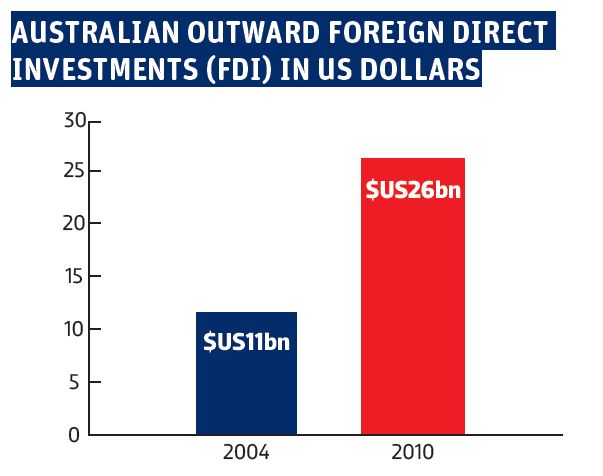Glocalisation calls for HR executives to mix both global and local initiatives. When executed correctly, the benefits can flow evenly between local subsidiaries and the corporate headquarters based overseas. Andreas Raharso outlines how to make it work
In spite of the global recession following the 2008 financial crisis, globalisation continues at a steady pace. Some would argue the primary driver of globalisation today is multinational corporations (MNCs), but Australian firms are also aiming to compete on the global stage as indicated by the country’s increasing levels of outward foreign direct investments (see fig.1).
 (Click on image to enlarge)
Figure 1
(Click on image to enlarge)
Figure 1 – Australia’s Outward FDI jumped by 141% in just six years, an indication of Australian firms’ increasing expansion into overseas markets
As more Australian companies set up local or regional offices in emerging and culturally diverse markets, HR professionals are being tasked with implementing sustainable human resource man-agement (HRM) practices that are sensitive to local needs. HR departments traditionally rely on tools such as rewards or training to align employee behaviour with organisational goals. However, while these tools alone may be quite effective on home turf, there is also a need to align and ‘glocalise’ – a portmanteau that combines ‘global’ and ‘local’ – these initiatives when it comes to foreign subsidiaries. Furthermore, simply targeting behav-ioural change, especially in a place with a vastly different culture, is not likely to produce lasting change, even if it is succeeds initially.
ORGANISATIONAL CULTURE AND GLOCALISATION
Implementing a new HR directive from HQ is essentially an exercise in changing behaviour. However, attempting to induce behavioural change directly is ineffective and does not have any long-lasting impact. Such an approach does not address the underlying drivers of behaviour and, eventually, people will simply revert to old and familiar ways. This is because the impetus to change does not reach the deeper layers of culture, which is comprised of the shared purpose and meaning within the group, as well as individuals’ underlying values and beliefs (see fig.2).
 (Click on image to enlarge)
Figure 2
(Click on image to enlarge)
Figure 2 - The highly visible aspects of culture is the tip of the iceberg; deeper drivers of change are not easily observable but have the power to change behaviour permanently.
The key to reaching these deeper layers of culture is to first understand that culture goes beyond the most obvious facets of the day-to-day workings of organisations, and are instead embodied by structures, management systems and symbols, and organisational norms.
According to Hay Group’s model of organisational culture, culture is defined as: “The combination of organisational inspiration and purpose, motives and beliefs of individuals, and the norms and patterns of interaction of groups that drive both leaders’ and employees’ behaviours and results.” In other words, culture is the fabric that provides meaning and, in the absence of clear directives, guidance for people in the course of their work.
This means in the ideal multinational corporation, local and regional operations can be relied upon to act on their own initiative while still sharing a common fabric of meaning with the larger organisation.
But how do you go about implementing HR directives that originate from HQ in a local or regional office that may have very different cultures and norms? A potential solution lies in the adaptive process of ‘glocalisation’, which as the portmanteau suggests, calls for HR executives to think both globally and locally.
MIXING GLOBAL AND LOCAL
To think globally, the question HR executives must ask is, ‘What is the ‘personality’ of my organisation as a whole?’ Many senior executives struggle to answer this, but clearly defining this personality – the set of values and beliefs that guide how employees think and act on the job – will impact the way the organisation works. This ‘personality’ of an organisation is central to the organisation’s global culture and is a key factor in not only achieving a company’s goals, but also in attracting and retaining the best employees, creating a positive public persona, and strengthening stakeholder relationships.
Thinking locally, on the other hand, involves a commitment to understanding local cultural differences, especially those that underpin the business climate of the host country. Here, the question to ask is, ‘What factors make this particular area unique when it comes to conducting business?’ An external subsidiary of the MNC, staffed with mostly local employees, cannot be assumed to reflect the corporate culture of HQ in its entirety. Besides the socio-cultural differences that may exist, the lack of direct supervision from HQ means the local or regional office may have developed their own routines and working styles. A locally sensitive approach to implementing HQ’s initiatives requires the HR team to recognise elements of local culture compelling enough to demand some level of accommodation.
When recognising the need for balance between the global and the local, there may be a temptation to see glocalisation as a continuum between a state of global consistency, under which universally standardised policies are implemented as-is locally, and a state of local responsiveness, under which fully locally-tailored policies are developed. However, as we delve into the pre-planning stage of the glocalisation process, we will see the two states should not be treated as part of a continuum.
GETTING STARTED
As a first step, it is crucial to start thinking about what makes your company what it is – the ‘personality’ of the organisation mentioned earlier. This should be treated as a non-negiotable aspect of organisational culture. For example, a company that places a high value on individual merit in its management philosophy cannot, without creating an internal rift in its culture, start treating personal relationships as the primary determinant of career progression simply because it faces pressure to accommodate local customs.
The organisation’s ‘personality’ is an important consideration in the attempt to adapt global HR directives to local situations. However, the organisation’s overarching goals, as well as the purpose or intention behind any new initiative to be implemented, must also be considered. Near or at the beginning of the glocalisation process, HR executives must ask themselves: as long as an initiative stays faithful to its purpose or to the goals of the organisation as a whole, how can this initiative from HQ be tailored to fit local norms?
The key to effective glocalisation, therefore, is not to approach global consistency and local responsiveness as a simple continuum along which one is pursued at a cost to the other. Rather, there are certain issues that call for strict global consistency, namely the organisation’s meaning and purpose and the ‘why’ behind any new initiative. The ‘how’ of implementation can be orientated towards local responsiveness.
COMING UP WITH THE PLAN
Having a proper understanding of how to start glocalising is more than half the battle won. Of course, in order to clinch victory one needs to move into the planning and execution stages. This is where we will not find a one-size-fits-all solution; any in-depth discussion will need to be driven by the particulars of each case and host country, which will vary wildly.
A framework comparing the global and local cultures can be useful to HR executives at this stage of the glocalisation process. Hofstede’s cultural dimensions theory is one systematic framework for assessing and differentiating national and organisational cultures. By describing the effects of a society’s culture on its members’ values and how this relates to behaviour, HR executives can classify a region’s cultural values into scaled dimensions that facilitate comparisons with other cultures.
STOCKMANN’S ESTONIAN EXPERIENCE
The case of Finnish retail trade company Stockmann setting up its first department store in Estonia is an example of how standardised HR policies can be strengthened by tailoring them around the local culture1. When the Estonian outfit was first established in 1993, performance management policies in the company were initially standardised across all geographical units. But within a few months of operations, HQ identified challenges arising from local cultural differences, especially in the area of personnel development.
For the Finnish HQ, customer satisfaction was the central objective (ie the ‘personality’ of the organisation) in all its areas of business. One Finnish HR executive notes when the company expanded into Russia four years earlier in 1989, the company had no issues with customer service as “Russians are open and go more easily and naturally to customers”.
But in Estonia, the biggest challenge was to develop customer service skills. The same executive commented, “Customer service isn’t characteristic of Estonians. Estonians are a bit withdrawn, a bit passive, they don’t start talking whatever with a stranger.” To remedy this and ensure HQ’s mandate of customer service was maintained, a local training firm was brought in to emphasise the training of customer service skills for Estonian employees. To further inculcate customer service in staff, competitions between departments were held and good sellers given bonuses.
The influence of Estonia’s reticent culture on the organisation’s personnel development program can be explained by Hofstede’s cultural dimensions, specifically the Uncertainty Avoidance Index (UAI). The UAI measures the way a society deals with the fact that the future is unknown – ambiguity brings with it anxiety, and different cultures have learnt to deal with this anxiety in different ways.
Estonia’s high UAI score of 602 means locals have a high preference for avoiding uncertainty, and may also tend to be suspicious towards strangers. Therefore, from a socio-cultural perspective, Hofstede’s framework allows us to understand why Estonian employees are passive and do not actively approach customers.
In the end, the Finnish company’s basic training and development practices for employees were the same in both the home and host countries, but staff development programs in Estonia were localised to address the lack of customer service stemming from the reticent local culture present in the country. While the Finnish firm’s central objective of customer service was non-negotiable across all of its geographic units, the performance management and training systems in Estonia were negotiable, and moulded to realise this central objective.
SUSTAINABLE GLOCALISED STRATEGIES
Once a modification to HR policy has been determined to be in the best interests of local employees, the plans for glocalisation must be communicated back to global HQ for approval. Although HR executives may introduce modifications, it is ultimately crucial HQ finds the glocalised form of the initiative compatible with the larger organisation’s aims. Otherwise, the global aspect of the effort would be nullified. Emphasising the ‘win-win’ nature of the effort will go a long way in convincing HQ to give its approval to the plan and ensure glocalisation efforts are supported over the long term.
 About the authors
Dr. Andreas Raharso is director, Global R&D Centre for Strategy Execution at Hay Group.
About the authors
Dr. Andreas Raharso is director, Global R&D Centre for Strategy Execution at Hay Group.
Contributing author Senthil Sukumar, is a research and content strategist, and Moses Lemuel is an applied research analyst at Hay Group.




 About the authors
About the authors